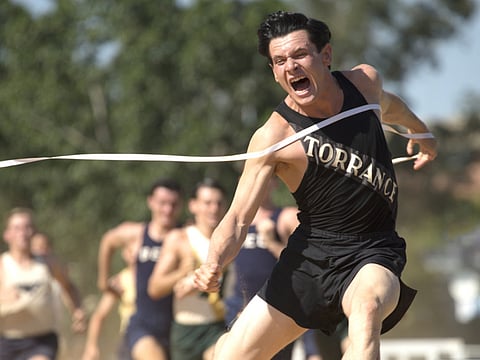‘Unbroken’ tells half of Japan’s war story
Attacks on Jolie’s film are part of a revisionist recrudescence under Abe

In the just-released film Unbroken, as in real life, US Army Air Corps Lt. Louis Zamperini was beaten, starved and forced to work as a slave labourer by his Japanese captors. Things could have been worse. Like some other war prisoners held by the Japanese, Zamperini could have been used in biological warfare experiments. Or vivisected. Or beheaded, with parts of his body then eaten by his captors. As the historian Daqing Yang notes, 9 out of 10 US prisoners of war who died in captivity in Second World War did so at the hands of the Japanese.
In Japan, where Unbroken does not yet — and may never — have a release date, Right-wing nationalists have protested the film as racist and inaccurate. “It’s pure fabrication,” asserted a representative of one such pressure group, the Society for the Dissemination of Historical Fact. Online petitions have described director Angelina Jolie as a “demon” and called for her to be banned from Japan.
Unfortunately, the attacks on Jolie’s film, which is really much less about Japanese brutality than the resilience of the human spirit, are part of a revisionist recrudescence under the administration of Prime Minister Shinzo Abe. Several of his Cabinet members and appointees have pushed to whitewash or deny the Japanese military’s forced wartime recruitment of women as prostitutes, the 1937 Nanjing Massacre of Chinese civilians by Japanese troops and other wartime atrocities, targeting journalists and scholars who dare to disagree.
Such behaviour has roiled Japan’s relations with China and South Korea and undermined its alliance with the US. And it has cast an ugly shadow over the impending 70th anniversary of the end of the Second World War. Yet, that occasion also offers an opportunity for both Japan and the US to relearn lessons about the uses and abuses of history, beginning with the folly of trying to cover it up.
In the two weeks following the end of hostilities on August 15, 1945, and the arrival of the first US troops on August 28, Japan’s military engaged in a wholesale destruction of its files. Some Japanese historians estimate, for instance, that as much as 70 per cent of the army’s wartime records were lost. Although the Americans, British, Chinese, Dutch, Filipinos and Russians each held separate war-crimes trials of Japanese defendants, their documentation has never been gathered in one place, making it harder to access. Meanwhile, Japanese Rightists have sought to discredit the remembered accounts of Korean “comfort women” as anecdotal or concocted memory. They have also exploited inaccuracies in sensationalist bestsellers such as Iris Chang’s The Rape of Nanking to try to discredit larger truths.
Yet, not only have many Japanese contributed unflinching histories of Japan’s wartime behaviour — many available in English — but voluminous, and damning, official records exist that have yet to be fully exploited. In 2006, the US government’s National Archives and Records Administration published Researching Japanese War Crimes, a guide to US intelligence reports, captured Japanese documents and contemporary news accounts contained in various US public archives.
It is not the kind of stuff you want to read on a full stomach: In the National Archives, for instance, you can find the transcript of the trial of Japanese officers who ordered the execution, and then the cooking, of four US Navy airmen downed in raids on Chichi-Jima — a fate that Lieutenant George H.W. Bush, who was also shot down on the raid, barely avoided.
To their credit, many Japanese scholars have drawn on such materials in their own work: US documents on Japan’s biological warfare experiments on Chinese prisoners, for instance, helped to blunt the 1980s attempt by Japan’s Ministry of Education to censor references to such crimes in history textbooks.
Any forthright exploration of Japan’s wartime cruelties, of course, must be matched by an acknowledgment of the battlefield savagery of US troops in the Pacific, where some members of the Greatest Generation pried gold teeth out of the mouths of still-living Japanese soldiers, strafed airmen in their parachutes, shot surrendering soldiers and sent Japanese skulls home to their sweethearts as table ornaments. Compared with the European theatre, it was not exactly the Good War: “Subhuman, inhuman, lesser human, superhuman — all that was lacking in the perception of the Japanese enemy was a human like oneself,” observed the historian John Dower.
Moreover, US archives lay bare another troubling aspect of US wartime history: The willingness to collaborate with Japanese war criminals in the name of larger strategic interests. As Michael Petersen documents, General Charles Willoughby, a die-hard anti-Communist who was Douglas MacArthur’s intelligence chief, oversaw a (remarkably feckless) post-war spy network that included Masanobu Tsuji, the Imperial Army officer who helped organise the Bataan Death March that killed so many of the US soldiers that MacArthur had abandoned in the Philippines.
Still missing are documents showing what happened to data from the human experiments by Unit 731, the notorious Japanese chemical and biological warfare outfit headed by General Shiro Ishii, who was never prosecuted by the Allies. The records also shine a light on the expedient clemency policies towards suspected war criminals such as Nobusuke Kishi, a post-war prime minister who also happens to be Abe’s grandfather.
That raises a final historical irony worth pondering over the coming anniversary year: The US responsibility for shielding the progenitors of Japan’s latter-day revisionists from accountability and prosecution. Even as late as the 1990s, the US State Department was arguing against releasing information on early Cold War payments by the Central Intelligence Agency to right-wing politicians from Japan’s ruling Liberal Democratic Party. Such behaviour helps explain why Unbroken describes not just Louis Zamperini’s spirit, but the resilience of Japan’s rightists.
— Washington Post
James Gibney writes editorials on international affairs for Bloomberg View.
Sign up for the Daily Briefing
Get the latest news and updates straight to your inbox


